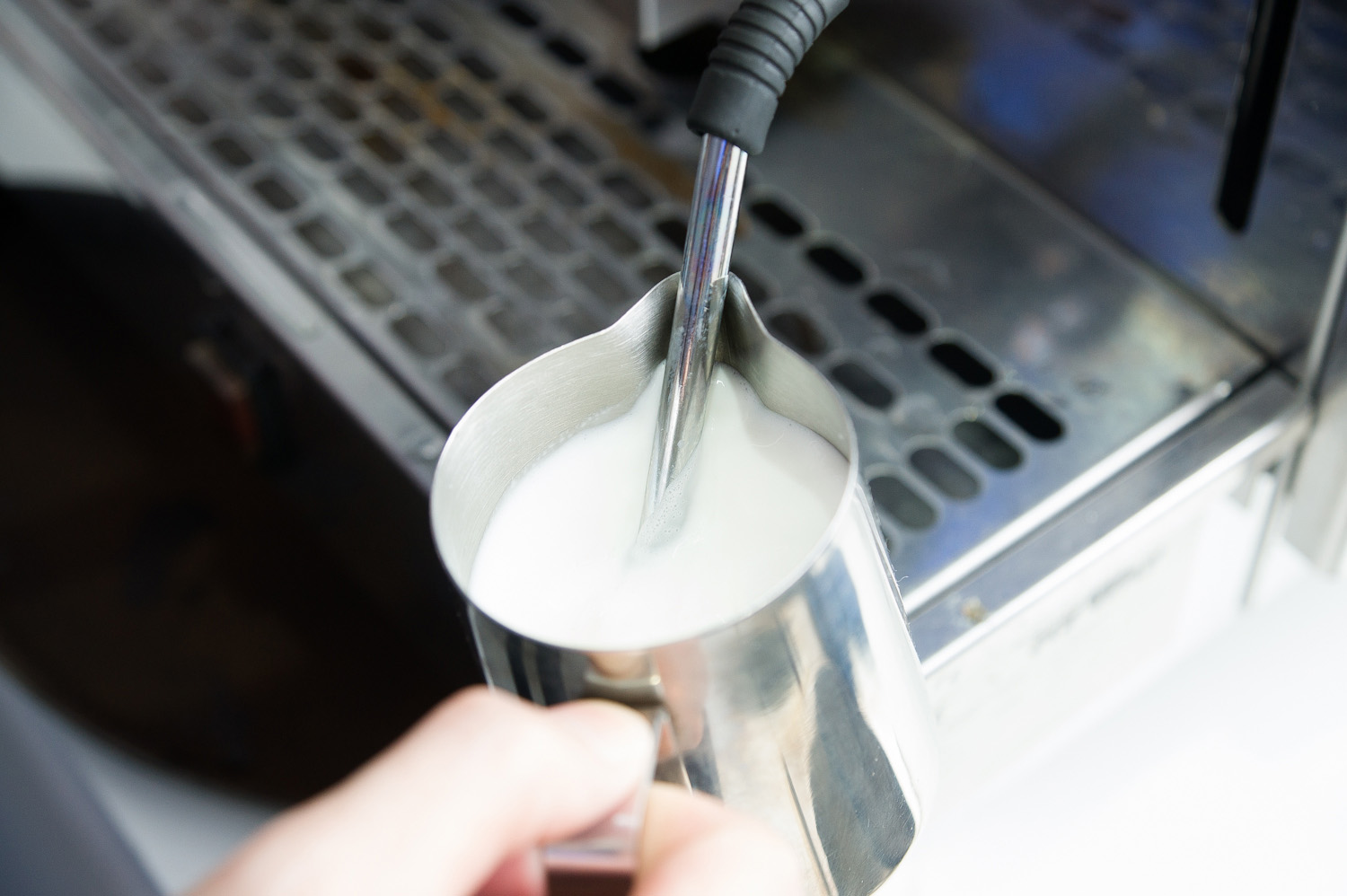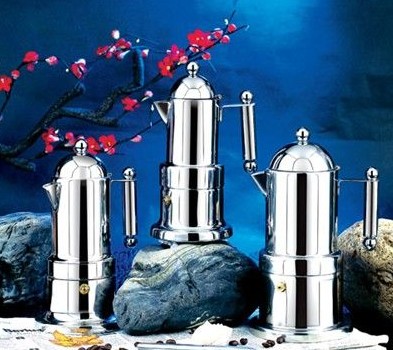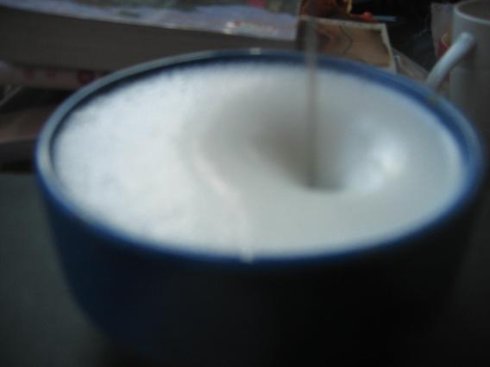Key points in the production of espresso: introduction of technical skills and matters needing attention in making milk foam

Espresso machine
At present, all espresso machines on the market have steam pipes for foaming.
Flower cup
It is better to have a stainless steel flower cup with a water outlet. You need the kind of flower cup whose temperature can change with the milk, so you can feel the temperature of the milk at any time without steaming it too hot. Stainless steel happens to have this property. The outlet can help you with milk when you pull flowers.
The milk used in lattes has a fat content of about 3%. The less fat, the harder the foam.
Milk foam
The main thing to keep in mind when foaming is to stop when the temperature reaches the right point. The appropriate temperature refers to 55-65 °C, depending on your taste. Foaming for too long will condense the milk and change its taste (and cappuccino will be too hot). Overheated milk can also make the foam too hard. How different will the foam be? Here are some typical examples:
Blistering
If you are distracted or distracted when foaming, it is easy to cause the steam pipe to be above the surface of the milk rather than just below the surface of the water. The result is milk spatter and larger milk bubbles. Of course you can still get a lot of foam in the flower cup, but it will taste bad. : (
Too hard
The hard foam looks stiff, and it doesn't mix with the coffee when you pour it into the coffee, but accumulates on top of your coffee like fluffy beaten cream. If you play a little longer, it will be layered, 90% of which is flowing milk, and a thick hard foam lid floating on it. When you pour it into the coffee, the milk will flow out of the flower cup first. You must scoop the foam into the coffee cup with a spoon. : (
Smooth
If you do everything right, when you pour it out, the milk looks smooth and creamy, a bit like pouring yogurt. Milk your espresso will mix perfectly, and crema will color the surface of the milk to form a typical brown edge of cappuccino. :)
Milk that has been beaten again often makes hard foam. The trick is to beat the right quantity and quality of foam in the flower cup at the right temperature. To foam well, you need to know how quickly your machine heats up the amount of milk you want. A good advice is not to take less than two cappuccinos at a time when you start learning to foam.
Vapour
After the machine reaches the correct temperature, turn on the steam switch, release the water that always exists in the steam pipe, and then turn off the steam switch.
Put the nozzle under the surface of the milk and turn on the steam. If you turn on the steam when the nozzle is above the liquid level, you will get larger bubbles, and it will take a lot of effort to get rid of these bubbles.
Slowly take the nozzle to the surface of the milk. Stop (stop just as it breaks the surface) just as the nozzle is about to come off the surface. Now that the air is sucked into the milk, you will hear a typical hiss. If you accidentally take the nozzle out of the water, the pressurized air will blow on top of the milk instead of into the milk, resulting in large bubbles.
At this stage, there is no doubt that you have formed small and medium-sized bubbles on the surface of the milk. Now we will try to get rid of them. There will be a whirlpool where the air blows into the milk. All the bubbles on the surface will be pulled into this whirlpool and disappear. It is still important to put the nozzle in the right place to avoid new bubbles.
Now you have a texture made of tiny bubbles. Put your empty hand on the flower cup to feel the temperature of the milk. When the foam rises, you lower the steam pipe carefully so that it touches the milk. If you are satisfied with the amount of foam and the milk is not warm enough, you can lower the nozzle into the milk. Now the milk is beginning to swirl. By doing so, the milk can be evenly heated by steam. When your hands feel a little hot, keep the nozzle below the liquid level and turn off the steam.
Whirlpool and pour
There are still bubbles in your foam a lot of times. A good way to get rid of these bubbles is to tap the flower cup on the workbench. Don't knock too many times so as not to cause too much foam.
A good way to judge whether the milk is thick enough is to rotate the flower cup so that the milk begins to form a whirlpool. You have to make more cappuccinos to learn what milk should look like. But here are some suggestions:
You can also tilt the flower cup to see how thick the milk is in the outlet.
Milk should not be too thick, because if it is too thick, it will not mix well with coffee.
The milk should look like you're pouring yogurt.
Pour the milk slowly. If it looks easy to flow, just wait a few seconds. By waiting for the air that has been blown into the milk to rise to the surface, the milk can be layered and the foam floats on it. It's like what happens after the black beer is poured out. In order to get the correct cream properties, you now need to blow the milk out of the whirlpool to mix it. You may get a nice cappuccino by doing this, but it may not be two.
Source:
Yuhuan's blog
Important Notice :
前街咖啡 FrontStreet Coffee has moved to new addredd:
FrontStreet Coffee Address: 315,Donghua East Road,GuangZhou
Tel:020 38364473
- Prev

The brewing method of individual coffee: the brewing of mocha pot is very different from other brewing methods.
First, light: 1. Grind coffee powder to medium thickness 2. The distance from adding cold water to the water level of the lower pot is about 0.2~0.5MM 3. Heat the pot on a gas plate over medium heat until a few medium bubbles rise from the bottom of the pot to the surface of the water. Do not let it boil. While waiting, put the coffee powder into the powder trough, preferably full, gently tap the powder trough with your fingers, and then hold the powder trough flat to make a horizontal circle.
- Next

Main points of espresso production: what kind of milk should be chosen for playing milk foam?
When we make cappuccinos or lattes at home, we need a cup of good quality foam. While the quality of milk foam affects the taste of Cabo and latte, the difficulty of playing milk foam lies in the choice of milk. I also saw some friends in the group ask, so let's share it today. As the saying goes: a skillful wife cannot make bricks without rice, and the choice of milk is also very important when getting rid of foam. Cattle
Related
- What is the meaning of lactic acid fermentation with coffee bean treatment?
- How to judge the state of foam by sound?
- How does the latte pull out the unicorn pattern? Come to get for a little trick to improve the flower pull!
- Will flower pulling affect the taste of the latte?
- Do you know the history of coffee?
- The difference between honey treatment and sun washing what is raisin honey treatment?
- What kind of milk can a novice use to make coffee foam to keep the foam longer? The correct method and skills of milking tutorial sharing
- Why do washed coffee beans taste sour? Flavor characteristics of washed Coffee
- Introduction to the skill of how to practice the size and height of water injection around the circle of hand-brewed coffee
- How do beginners practice coffee flower drawing from scratch?

